Residents want to know: How do you decide safe levels of hydrogen sulfide?
The story was originally published by the San Diego Union-Tribune with support from our 2024 Data Fellowship.
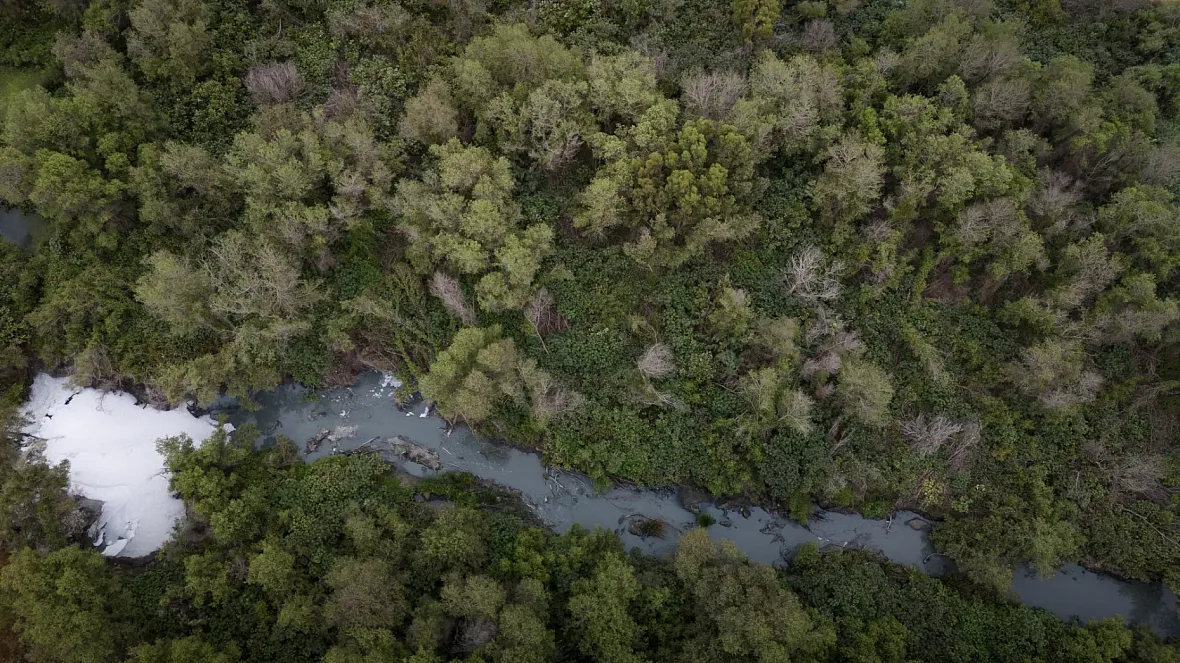
The Tijuana River flows on Wednesday, June 4, 2025 in Tijuana River Valley, California.
(Ana Ramirez / The San Diego Union-Tribune)
It’s just past 9 a.m. on Nov. 25, 2024, when the inaugural public notice goes live.
The San Diego County Air Pollution Control District (SDAPCD) is issuing an odor advisory for communities potentially affected by odors from the Tijuana River Valley.
Some individuals may experience odor-related symptoms such as headaches and nausea.
Limit outdoor activities if you smell odor that is bothersome.
If symptoms from strong odor persists, are worrisome, or worsen, seek medical care.
The odor comes from a toxic gas that’s colorless and smells like rotten eggs. It’s hydrogen sulfide, or H2S, a byproduct of the millions of gallons of untreated sewage from Mexico that regularly chokes one of America’s most endangered rivers, the Tijuana River.
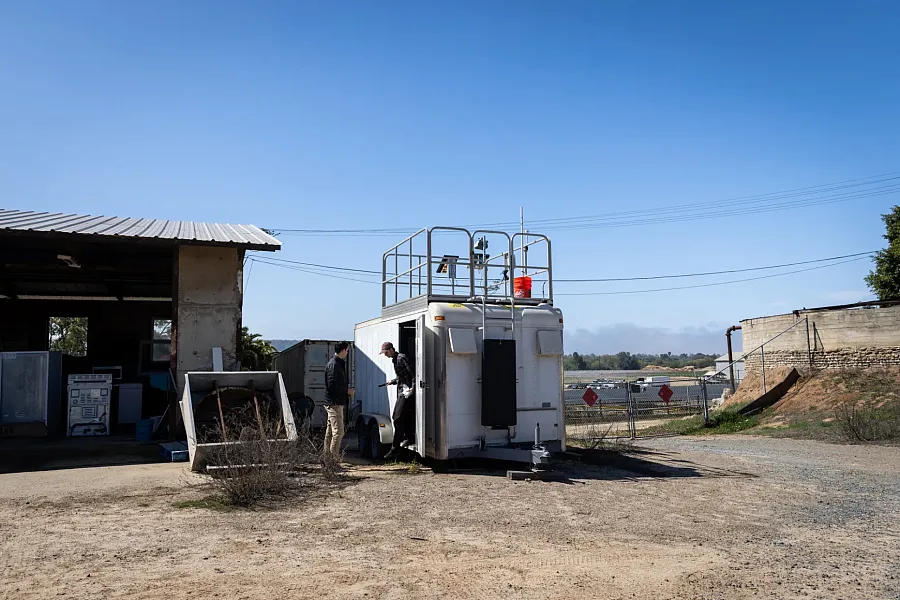
Scientists from Scripps Ben Rico, 28, left, and Tobie Bloom, 24, visit a trailer that has a hydrogen sulfide monitor to pull data on Thursday, April 10, 2025 in San Diego, California.
(Ana Ramirez / The San Diego Union-Tribune)
UC San Diego researchers, led by Kim Prather, recently found that sewage-linked bacteria and toxic chemicals in the river are airborne. In the past couple of years, the volume of sewage flows, laced with contaminated stormwater, noxious chemicals and trash, has been the highest in the last quarter-century, worsening conditions for those living and working nearby. Scientists’ preliminary work has shown that what has long been a water quality crisis is also an air quality problem.
Implementing the air district’s network of monitors in Imperial Beach, Nestor and San Ysidro and its advisory system were some of the first significant efforts by a public agency to acknowledge the experiences of local communities. The data from the monitors has helped district scientists find patterns about the gas: concentrations typically skyrocket at night and the higher emissions are lasting longer before dipping to levels the state says won’t cause a nuisance.
But the data remains woefully insufficient to conclude what long-term exposure means for individuals, especially for vulnerable groups such as children or those with respiratory problems. And there are only three monitors generating information for a border region that is home to tens of thousands of residents who have raised concerns for years. Significantly more information is missed every day without a wider net for data being cast across South County communities.
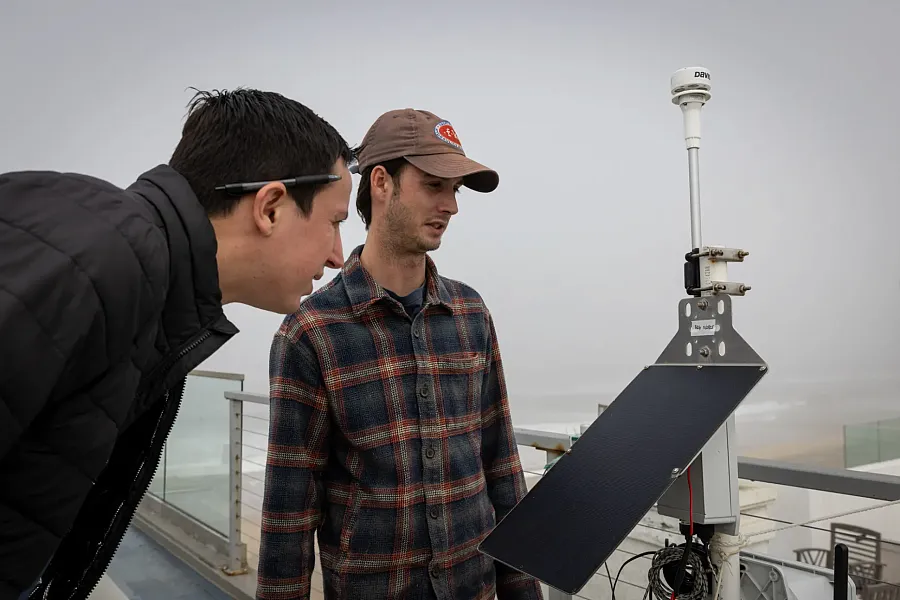
Scientists from Scripps Ben Rico, 28, left, and Tobie Bloom, 24, look at an air quality monitor on Thursday, April 10, 2025 in Imperial Beach, California.
(Ana Ramirez / The San Diego Union-Tribune)
However, the available data indicates that for the past several months there has been a persistent presence of hydrogen sulfide, causing intermittent exposure to levels that some studies and environmental health experts suggest can cause respiratory complications.
Hydrogen sulfide has historically been poorly documented. In the county, air pollution regulators had not previously tracked it, and obtaining accurate readings required some trial and error. And while the gas is well known for its short-term risks in occupational settings, less is known about the consequences of long-term exposure.
Even tiny amounts can pose risks

Scientists from Scripps Ben Rico, 28, left, and Tobie Bloom, 24, pull data from a hydrogen sulfide monitor on Thursday, April 10, 2025 in San Diego, California.
(Ana Ramirez / The San Diego Union-Tribune)
Hydrogen sulfide is naturally present in the environment.
Some natural sources include volcanoes, swamps, and human and animal waste. Industrial activities such as natural gas drilling, wastewater treatment and paper manufacturing can also produce the gas.
According to the federal Agency for Toxic Substances and Disease Registry, concentrations produced by natural sources or found in urban areas typically fall below 1 part per billion (ppb), considered unlikely to cause harm. In the workplace, the Occupational Safety and Health Administration allows for a daily ceiling of 20,000 ppb.
Parts per billion refers to the amount of a pollutant in the air. According to the Washington, D.C.-based nonprofit Environmental Working Group, one drop of water in an Olympic-sized swimming pool equals 1 ppb.
The state and federal governments have different thresholds for hydrogen sulfide exposure. Exposure to the gas above the established limits won’t necessarily lead to health problems, but it may increase a person’s risk of respiratory symptoms, such as coughing and wheezing.
Although concentrations as low as 1 ppb may appear negligible, even such tiny amounts of chemicals can pose risks to public health, said Richard Gersberg, a water quality researcher at San Diego State University’s School of Public Health.
What the air district’s data shows
The San Diego Union-Tribune reviewed hydrogen sulfide data that the air district collected between Sept. 16, 2024, and May 3, 2025, at three sites: Berry Elementary School in Nestor, the Civic Center in Imperial Beach and a fire station in San Ysidro.
Data shows that sewer gas was consistently detected in the air and frequently exceeded state and federal thresholds. Nestor, a low-income community in south San Diego already burdened with other air pollution issues, had the highest recorded readings. Although there is not yet enough data to document chronic exposure, readings indicate cause for concern. Weekly hourly averages showed that emissions detected from Nestor have repeatedly exceeded the federal standard of 1.4 ppb since the week of Oct. 6, 2024, when the San Diego County Air Pollution Control District began collecting data. Concentrations ranged between 1.9 ppb and 30 ppb. Between Feb. 16 and April 26, readings exceeded the state’s chronic standard of 8 ppb multiple times. For two consecutive weeks, from April 6 through April 19, the weekly hourly averages were 30 ppb and 28 ppb, respectively.
At Imperial Beach’s Civic Center, where the district began recording levels the week of Dec. 22, 2024, weekly averages were consistently above the federal standard of 1.4 ppb, but did not reach the state’s threshold of 8 ppb. The range fell between 1.5 ppb and 6.4 ppb.
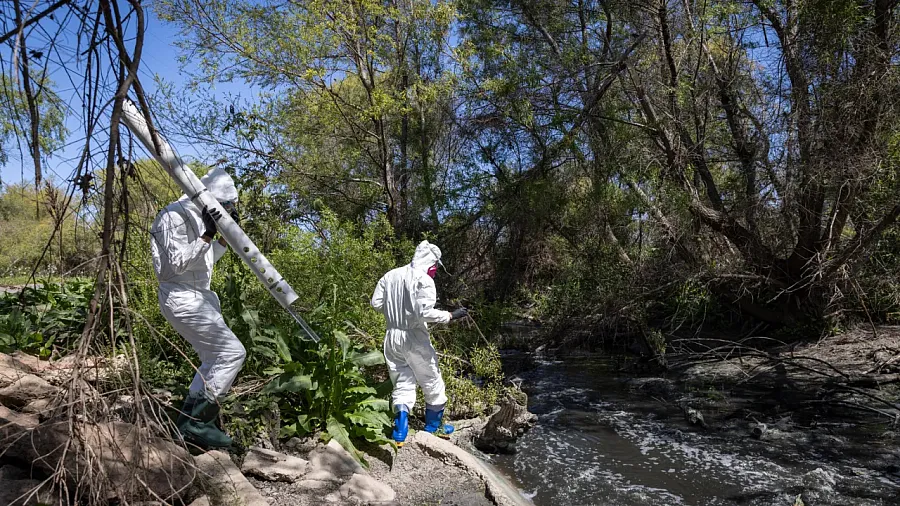
Scientists from Scripps Ben Rico, 28, left, and Tobie Bloom, 24, location scout for where to put a water probe on Thursday, April 10, 2025 in San Diego, California.
(Ana Ramirez / The San Diego Union-Tribune)
In San Ysidro, at San Diego’s Fire Station 29, weekly averages ranged between 0.9 ppb and 2.9 ppb.
Very few times did hourly levels read 0 ppb, meaning no presence of the gas.
“In these areas you’re seeing, through the measurements, that there is a persistent presence of (hydrogen sulfide), with daily and even weekly averages sometimes exceeding guidelines,” said Wilson Rumbeiha, an environmental health toxicology professor at the University of California, Davis. “Now, whether it is reaching health levels of concern, that’s a different question.”
Researchers, public health experts and numerous studies agree that the impact of chronic, low-level exposure to sewer gas is not clear. One primary reason is the difficulty in accurately measuring exposure due to several factors affecting results, such as wind, temperature, the proximity of sources, people’s varying sensitivity and the fact that the environment is also full of other pollutants.
“When you look at the aggregate of all the scientific studies that are out there, and even studies of studies that have also been done in the medical literature, right now, we don’t have, really, any conclusive data that says exposure to these low levels over a long period of time is going to cause any permanent damage,” said Cyrus Rangan, assistant deputy director for the Center for Healthy Communities at the state Department of Public Health, who is working with county public health officials.
One of those “studies of studies,” a 2023 review from the University of Michigan’s Department of Environmental Sciences, found that exposure to levels below 30 ppb “has been associated with increased prevalence of neurological effects, and increments below 0.001 ppm (1 ppb) in H2S concentrations have been associated with ocular, nasal and respiratory effects.”
The study concluded: “Long-term community-based studies are needed to confirm the low concentration findings and to refine exposure guidelines. Revised guidelines that incorporate both short- and long-term limits are needed to protect communities, especially sensitive populations living near H2S sources.”

A puddle of cloudy water in the Tijuana River on Thursday, April 10, 2025 in San Diego, California.
(Ana Ramirez / The San Diego Union-Tribune)
Ankita Kadakia is the county’s deputy public health officer. Over the past year, she has led the department and helped develop public health guidance related to Tijuana River foul odors and reported health symptoms. She said officials are “absolutely concerned” about what exposure to long-term, low levels means for residents. That’s why, she added, department officials have enlisted the help of outside experts, including a neurotoxicologist at the EPA and Rangan.
That guidance, launched by the air district late last year with help from the county and state and federal agencies, is a color-coded index recommending how the public and schools should respond to various hourly levels of hydrogen sulfide. It has four tiers:
0-4.9 ppb: No action needed because most people won’t smell the sewer gas stench.5-29.9 ppb: People sensitive to the odor should limit outdoor activities.30 ppb or higher: Many could experience odor-related symptoms, such as headaches. People should prevent odor from coming indoors, use air purifiers and seek medical care if symptoms persist. Schools are advised to limit outdoor activities or switch to indoor alternatives.Above 27,000 ppb: People could experience serious, lasting adverse health effects. First responders would evaluate whether people need to shelter in place or evacuate.
Crossborder pollution from the river emitted the sewer gas more frequently and at higher levels in April than in other months, sparking odor complaints, questions about what officials are doing and when the crux of the decades-long problem will finally be fixed.
April
Those high emissions came into sharp focus at 8 p.m. on April 9. Emissions peaked at 498 ppb, the highest reading the Nestor monitor had recorded at the time, and a 16-fold increase above the state’s hourly standard of 30 ppb.
The California Air Resources Board adopted the standard in 1969 for odor control. It was purposefully set low to be “more health protective than higher (hydrogen sulfide) standards set elsewhere,” said Amy MacPherson, spokesperson for the state agency.
“The health rationale for the (30 ppb) standard is based on the presumption that the ability to detect the odor from hydrogen sulfide is enough to trigger a headache or nausea,” MacPherson added. “Having the lower, odor-based standard also gives local air districts the ability to begin investigating (hydrogen sulfide) complaints sooner, rather than waiting until they reach levels that pose a bigger threat to public health.”
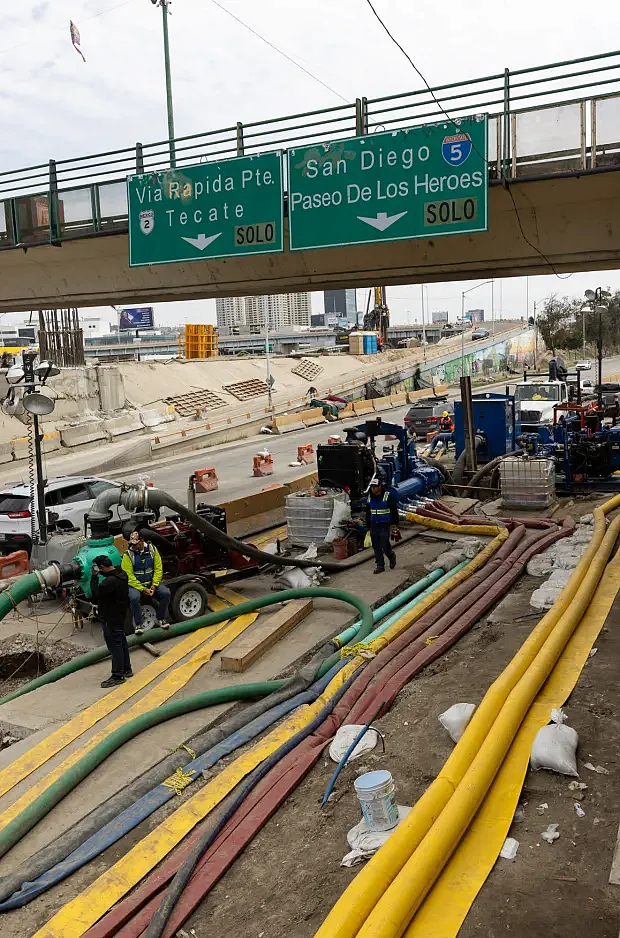
Construction of the international collector project being fixed on Monday, March 17, 2025 in Tijuana, Baja California. The sewer main is Tijuana’s largest and directs sewage to treatment plants versus the river.
(Ana Ramirez / The San Diego Union-Tribune)
The average amount of hydrogen sulfide to which people were exposed on April 9 was 113 ppb.
On the night of April 8, hourly concentrations from Nestor ranged from 32 ppb to 315 ppb from 8 p.m. through 7 a.m. Only once, at 10 p.m., did they fall below the threshold.
These concentrations increased as Mexico worked to rehabilitate a major pipeline that is supposed to divert wastewater from the Tijuana River to treatment plants on both sides of the border. But during construction, because Mexico didn’t yet have the infrastructure in place, it discharged about a half-million more gallons of polluted water into the river the night of April 8.
Sometimes when the polluted river flows rose, the levels of hydrogen sulfide also seemed to increase within the following hour. For example, on April 3, the flow increased from 4.7 million to 5.9 million between 2 and 3 a.m. Concentrations of the gas from Nestor jumped from 4 ppb at 3 a.m. to 31 ppb by 4 a.m.
Nearly every day in April, emissions of the colorless gas detected from Nestor climbed above 30 ppb for at least one hour per day. From Imperial Beach, concentrations surpassed the threshold for almost half the month. On several days, levels rose more than tenfold for several consecutive hours.
“Generally, we’ve been seeing the higher levels of H2S at night, which definitely correlates with the higher river flows and lower wind speeds in that area,” said David Sodeman, the air district’s chief of Monitoring & Technical Services Division.
April had more than a dozen incidents between Nestor and Imperial Beach where hourly hydrogen sulfide levels exceeded 200 ppb. Because the four-tiered index requires a “multiagency review” of gas levels if they exceed 200 ppb for more than one hour, local air pollution control regulators and county public health experts met daily on several occasions.
But Kadakia said officials agreed that emissions still had not risen to a level where more recommendations for the public were necessary.
“So far, we are being told that our guidance is appropriate and that the public health guidance that we’re putting out is the correct guidance to follow,” she added. “If there are changes to that, we will actually make those changes and notify the public.”
Like the state’s rationale for choosing a lower threshold, officials said 200 ppb was selected to give them time to act before H2S emissions approach 510 ppb, a federal threshold for a one-hour average.
The EPA’s guidelines for one hour, which is considered a short-term exposure and is separate from the agency’s chronic measurement of 1.4 ppb, say that “the general population, including susceptible individuals, could experience notable discomfort, irritation, or certain asymptomatic nonsensory effects” at 510 ppb.
Efforts underway
The Agency for Toxic Substances and Disease Registry with the U.S. Department of Health and Human Services said it is reviewing data on hydrogen sulfide, surface water, sediment, soil, fish tissue and odor complaints “collected by government agencies and researchers to evaluate past, current, and potential future exposures.”
The two-part assessment is expected to produce an air-related report next year, followed by another on exposure pathways, such as water and sediment. The agency will issue recommendations to reduce or prevent harmful exposure based on its findings.
Key infrastructure upgrades recently completed in Mexico are expected to divert untreated wastewater from the Tijuana River Valley and reduce beach closures.

People walk on Thursday, Feb. 6, 2025 in Imperial Beach, California.
(Ana Ramirez / The San Diego Union-Tribune)
And Lee Zeldin, the new head of the Environmental Protection Agency, has vowed to pressure Mexico to hasten fixes. He said he is negotiating a “100% solution” with Mexico.
“Americans on our side of the border are fed up,” he told Congress members recently. “They don’t want a 90% solution, they want a 100% solution.”

